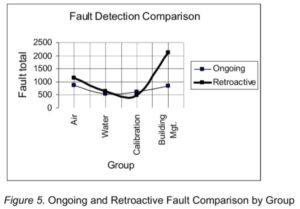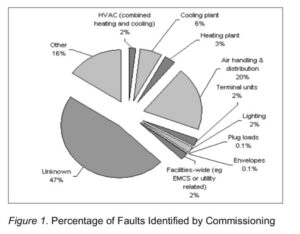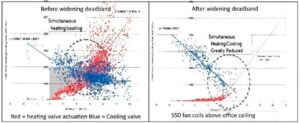Building commissioning
In this article I am going to talk about building commissioning for fault detection. These kind of failures (elements, controls, etc.) represent a negative impact of energy.

Though the repercussion of error detection with respect to the other two strategies (fine tuning or redesign) is not easy to determine. But without a doubt it is an interesting area that deserves to dedicate some efforts. The following table is indicative only:

In fact, it should be the first phase to work on, before fine-tuning or redesign. The reason is that it does not make much sense to work with data, with variables or elements that may be victims of an error. This will affect the conclusions we make and may cause a savings initiative to fail.
Therefore, I will enter here in the description of the concept of error detection through buildings commissioning. My colleague, doctor Steven P. Driver, global energy program manager at Sanofi, is the author of a very interesting dissertation about the impact of building inspection through two techniques: retroactive inspection (human collect data) or continuous (computers collects the data). The first would be detection using algorithms that work on the variables collected by the building management system (BMS). And the second would be the detection by specialists who carry out a thorough review of a building and its systems.
In my previous article, fault detection (automatic), I appropriate the concept of automatic detection and I used an example to explain the it.
In Driver’s study, data was collected from a group 80 edifices subject to building commissioning equally divided to apply each of the two types of detection. The objective of the study was to find the differences between the two types of surveillance. The detection of errors is related to a lower energy consumption of buildings which is responsible for the reduction of operating costs and increase of greenhouse gases.
The quantitative conclusion is that a total of 4196 faults were identified using the retroactive commissioning process and 2847 faults were identified using the ongoing commissioning process. So the automatic detection is not negligible. In addition, both types of detection feedback on themselves. In the second part of the study, the number of detections in each group increases thanks to this enrichment.

Although retroactive commissioning quantitatively identified more faults than ongoing commissioning by type, the majority of the faults were related to issues not directly affecting energy consumption alone. Whether ongoing or retroactive commissioning is selected, energy saving value will be added. Importantly noted, more faults can be detected by combining the means and methods from both commissioning types.

Below, represented as a percentage is the following figure:

One example is simultaneous heating and cooling which is responsible for up to 15% of all energy lost in commercial buildings. During research, simultaneous heating and cooling was found to 415% more effective with ongoing commissioning than with retroactive commissioning.

Understanding the differences between ongoing and retroactive commissioning faults detected could contribute a significant amount of knowledge to the industry. In the event the theories cited in the research were fully implemented, and providing results do not deviate substantially from the 40 buildings assessed in context of this study, ongoing commissioning process could realize up to 2451 additional faults detected given a population of 40 buildings (average of 63 per building) in 15 fault categories by utilizing attributes taken from retroactive commissioning process, a 58% gain. The retroactive commissioning process could realize up to 1092 additional faults given a population of 40 buildings (average 27 per building) in 17 fault categories by utilizing ongoing commissioning attributes, a 26% gain in total faults detected. Fundamentally, the cost of the energy savings must outweigh the cost of the building commissioning services in effort to generate a favorable ROI.
Inspired by doctor Steven P. Driver work, I have undertaken a pilot project of automatic detection in a singular building within a campus. His ideas and observations have been very useful to me. So I say goodbye by thanking him for its effort made in this interesting contribution.
